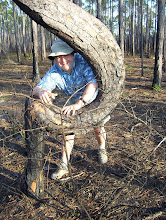 It takes a trained eye to notice granitic xenoliths. Xenoliths, as I have noted elsewhere, are literally "strange stones", bits of other rock that had gotten caught up in flowing magma and managed to maintain aspects of their original character, even if (as in the case of the photo above) they had become partially absorbed into the surrounding melt. Anyway, at first, the granite at my feet looked all alike, except where the solution pits poc-marked its surface, or where the joints ran that linked the pits in a geologic connect-the-dots. But then Julie pointed out a xenolith, and we were all fascinated at the discovery. After all, xenoliths can't be that common, can they, if it had taken us so long to find one?
It takes a trained eye to notice granitic xenoliths. Xenoliths, as I have noted elsewhere, are literally "strange stones", bits of other rock that had gotten caught up in flowing magma and managed to maintain aspects of their original character, even if (as in the case of the photo above) they had become partially absorbed into the surrounding melt. Anyway, at first, the granite at my feet looked all alike, except where the solution pits poc-marked its surface, or where the joints ran that linked the pits in a geologic connect-the-dots. But then Julie pointed out a xenolith, and we were all fascinated at the discovery. After all, xenoliths can't be that common, can they, if it had taken us so long to find one?The reality was that xenoliths of all sorts were all over both of the pavement outcrops we explored. Some were darker than the granite, and were probably true bits of the "country rock" that had been intruded, while others were lighter granitic phases. The novelty wore off, though I was still entranced by some of them -- particularly a large (maybe eight inches long) xenolith of finer grained granite that had weathered out a bit from the surrounding rock (see below). Julie explained to me that the xenolith, which was just downhill from a zone of finer-grained granite, was probably part of the finer-grained phase that, having cooled early in the history of the melt, somehow got ripped away from the rest and incorporated into the remaining

magma. Now, it rises from the granite pavement surface like a miniature Stone Mountain, channelling the flow of rainwater down the rock, causing a small solution pit to form just downhill. I took several photographs of it, thinking about how small a difference in erodibility can, in turn, can cause such noteworthy topographic expression. I was beginning to appreciate the subtle nuances of granite bodies, though the relationship was strictly plutonic.


No comments:
Post a Comment